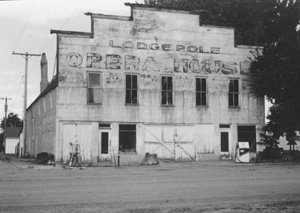
Frontier opera houses (Lodgepole, Nebraska, Opera House, built in 1911, closed in the late 1940s)
View largerFRONTIER OPERA HOUSES
Frontier communities regarded opera houses as visual symbols of prosperity–ence, promise, and culture. Though more properly "opera hall," the name "opera house" suggested refinement and elegance to local residents, so it prevailed. The opera house heyday lasted from about ten years after a town's founding until approximately 1917. Often on the second floor of the town's first brick building, opera houses contained an open space large enough for a significant portion of the community to congregate. All contained stages, some had permanent seating, but most consisted of a large room that could be arranged in a variety of configurations depending on need–dances, political meetings, banquets, basketball games, concerts, home talent shows, or professional entertainment.
Opera houses represented all types of vernacular Main Street architecture from the early two-part commercial block second-floor theaters to the one-part community auditorium models favored in the early twentieth century. These theaters functioned as the heart of frontier society, gathering places where folks could celebrate life and escape its daily rigors. Originally owned and managed by a civic-spirited merchant, they eventually passed into public ownership.
The opera house "season" lasted from late fall to early spring, beginning after the crops were in and lasting as long as the rutted roads remained frozen to accommodate evening travel. Frequent dances provided income for fire departments, dancing schools, lodges, bands, commercial clubs, and ball teams. Home talent performances by cornet bands, community instrumentalists, choral unions, local music students, and college or church choirs always earned high praise from local newspaper editors.
Several times each season, an opera house manager contracted for professional entertainment, often through a lyceum bureau booking agency. Unable to accommodate the more pricey offerings of combination companies booked out of New York, most Plains communities settled for concerts or other entertainments by smaller groups such as the Hallowell Concert Company, complete with baritone and lady trap-drummer; Round's Ladies Orchestra; the Schubert Symphony and Ladies Quartette; the Sue Burgess Concert Company, featuring contralto, reader, violinist, and pianist; Blind Boone, a pianist who drew rowdy crowds; and Mrs. Winters, a melodious whistler. More exotic musicians included the Royal Hawaiian Concert Company, Kulolo's Hawaiians, Vierra's Royal Hawaiians, Ramos' Spanish Orchestra, Losseff's Russian Quartet, the Swiss Bell Ringers, and the Chicago Boys' Choir, which traveled with marambophone, bagpipes, tambourine, castanets, and a harp.
Opera houses declined as a performance venue after 1917 for a variety of reasons related to twentieth-century technology. Many had reached the end of their architectural usefulness and could no longer safely support large crowds of people; the devastation of the 1903 Iroquois Theatre fire in Chicago, which killed 600 people, made the nation aware of the dangers of second-floor theaters. Automobiles, shifts in population, and postwar affluence meant smaller audiences in small towns. Most important, motion pictures proved more attractive to audiences and more cost-effective to managers than traveling troupes. Plains towns built no true frontier opera houses after World War I. Today, small Great Plains towns use community auditoriums to fill the nonentertainment functions of the opera house, while larger cities and television provide the performance venues.
D. Layne Ehlers Bacone College
Ehlers, D. Layne. "This Week at the Opera House: Popular Music Entertainment at Great Plains Opera Houses, 1887– 1917." Great Plains Quarterly 20 (2000): 183–95.
Zivanovic, Judith K., ed. Opera Houses of the Midwest. Manhatten KS: Mid-America Theatre Conference, 1988.
Previous: The Flatlanders | Contents | Next: Guthrie, Woody
XML: egp.mus.018.xml
